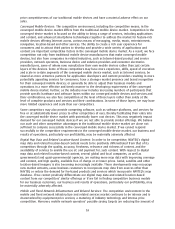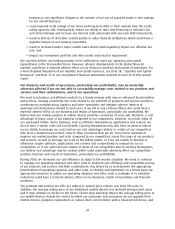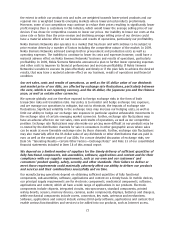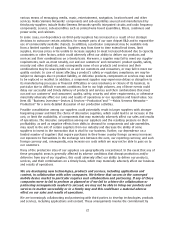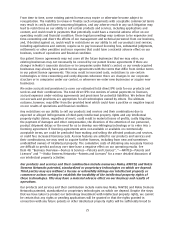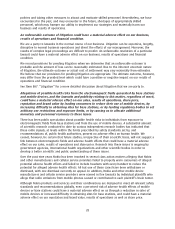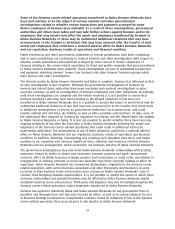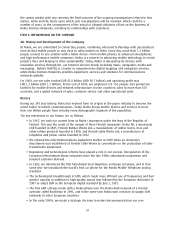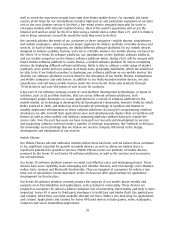Nokia 2009 Annual Report Download - page 28
Download and view the complete annual report
Please find page 28 of the 2009 Nokia annual report below. You can navigate through the pages in the report by either clicking on the pages listed below, or by using the keyword search tool below to find specific information within the annual report.protect our technology. Third parties may infringe our intellectual property relating to our non
licensable proprietary features or by ignoring their obligation to seek a license.
Any patents or other intellectual property rights that are granted to us may be challenged, invalidated
or circumvented, and any right granted under our patents may not provide competitive advantages
for us. Other companies have commenced and may continue to commence actions seeking to
establish the invalidity of our intellectual property, for example, patent rights. In the event that one
or more of our patents are challenged, a court may invalidate the patent or determine that the
patent is not enforceable, which could harm our competitive position. Also, if any of our key patents
are invalidated, or if the scope of the claims in any of these patents is limited by a court decision, we
could be prevented from using such patent as a basis for product differentiation or from licensing the
invalidated or limited portion of our intellectual property rights, or we could lose part of the leverage
we have in terms of our own intellectual property rights portfolio. Even if such a patent challenge is
not successful, it could be expensive and timeconsuming, divert attention of our management and
technical personnel from our business and harm our reputation. Any diminution of the protection that
our own intellectual property rights enjoy could cause us to lose some of the benefits of our
investments in research and development, which may have a negative effect on our business and
results of operations. See Item 4B. “Business Overview—Devices & Services—Patents and Licenses”,
“—NAVTEQ—Patents and Licenses” and “—Nokia Siemens Networks—Patents and Licenses” for a
more detailed discussion of our intellectual property activities.
Our sales derived from, and assets located in, emerging market countries may be materially
adversely affected by economic, regulatory and political developments in those countries or
by other countries imposing regulations against imports to such countries. As sales from
those countries represent a significant portion of our total sales, economic or political turmoil
in those countries could materially adversely affect our sales and results of operations. Our
investments in emerging market countries may also be subject to other risks and
uncertainties.
We generate sales from and have manufacturing facilities located in various emerging market countries.
Sales from those countries represent a significant portion of our total sales and those countries
represent a significant portion of any expected industry growth. Accordingly, economic or political
turmoil in those countries could materially adversely affect our sales and results of operations and the
supply of devices and network infrastructure equipment manufactured in those countries. Further, the
economic conditions in emerging market countries may be more volatile than in developed countries
and the purchasing power of our customers and consumers in those countries depends to a greater
extent on the price development of basic commodities and currency fluctuations which may render
imported products too expensive to afford. Our business and investments in emerging market countries
may also be subject to risks and uncertainties, including unfavorable or unpredictable taxation
treatment, exchange controls, challenges in protecting our intellectual property rights, nationalization,
inflation, currency fluctuations, or the absence of, or unexpected changes in, regulation as well as other
unforeseeable operational risks. See Note 2 to our consolidated financial statements included in
Item 18 of this annual report for more detailed information on geographic location of net sales to
external customers, segment assets and capital expenditures.
Changes in various types of regulation and trade policies in countries around the world could
have a material adverse effect on our business and results of operations.
Our business is subject to direct and indirect regulation in each of the countries in which we, the
companies with which we work and our customers do business. As a result, changes in various types
of regulations, their application and trade policies applicable to current or new technologies, products
and services including applications and content may adversely affect our business and results of
operations. For example, changes in regulation affecting the construction of base stations and other
network infrastructure could adversely affect the timing and costs of new network construction or
expansion and the commercial launch and ultimate commercial success of those networks. Export
26


